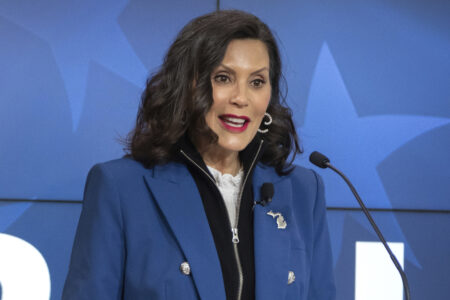Male teacher shortage continues to be a problem in Michigan

Courtesy Photo Pamela Rader, superintendent of Hillman Community Schools.
LANSING – A recent report found widespread teacher shortages to be a continuing problem in Michigan, with male teachers in especially short supply.
Their absence can adversely impact how well boys do in school, experts say.
Tara Kilbride is the interim associate director of the Education Policy Innovation Collaborative at Michigan State University and one of the authors of the collaborative’s “2025 Michigan Teacher Shortage Study” report.
“If boys are less likely to see people who look like them as teachers in their own experiences, it may be harder to see themselves as teachers,” she said. “Even if they have some interest.”
And that could be a problem in a profession that is already struggling to hire and retain teachers.
“We generally find that districts across Michigan have consistently faced challenges with educator staffing,” Kilbride said. “But the types of challenges differ quite a bit.”
“Teachers of color and male teachers have historically long been underrepresented in the workforce,” she said.
Kilbride said underrepresented groups also often have lower career retention rates. Even after showing initial interest in becoming a teacher, they’re less likely to stay.
She said several interrelated factors are probably at play, for example changing gender norms and the “teacher pay penalty.”
Michigan’s teachers are paid less than the national average, with an average salary of about $67,000 per year compared to more than $69,500 nationwide in the 2022-23 school year, according to the Economic Policy Institute.
The average salary nationally for people with bachelor’s degrees, however, is much higher. In 2023 men with bachelor’s degrees earned around $115,000 per year, while women with bachelor’s degrees earned about $83,000, according to the U.S. Census Bureau.
Starting teachers in Michigan face an even greater pay penalty, averaging just over $40,000 per year compared to the national average of more than $44,000, according to the National Education Association.
Kilbride said surveys have found that the public thinks teacher salaries should be higher than what they are.
“People in the community believe that teachers are underpaid,” she said.
Kilbride said while more people are entering teaching than leaving, there’s high turnover and less stability in the workforce.
“It also means the current teacher workforce is less experienced,” she said. “Early career teachers tend to be at the highest risk of leaving, so supporting them in their first couple of years is critical.”
Pamela Rader is the superintendent of Hillman Community Schools near Alpena, a small rural district with fewer than 500 students.
Rader said because of the teacher shortage, her district collaborated with other schools in the Alpena-Montmorency-Alcona Educational Service District to apply for a grant to provide financial support for new teachers to finish their certification.
Many new teachers now take alternative routes instead of going through traditional education programs. Those programs are often virtual-only, so teachers have less classroom experience, she said.
Rader said her district added an instructional coach to help new teachers with classroom management. The district also publicized open positions to parents and others in the community to get more applications.
Because of that, she said the Hillman district has been able to fill all open positions.
Rader said it’s important to have male teachers.
“A lot of our students come from homes that don’t have a male role model,” Rader said. “So having strong male role models in the building is very important.”
Rader said seven of the 30 teachers in the district are men, or about a quarter. That’s about the same as the state-wide average, according to the Michigan Department of Education.
When asked why more men don’t want to be teachers, Rader said she thinks men tend to have more options in careers than women.
“I think that traditionally, females look for jobs where they can still be Mom,” she said. “I think that plays a part in it.”
Another factor is the pay penalty, Rader said.
“If you’re in education, it is work of the heart,” she said. “You go into that occupation not number-one for the money. And men, typically, they’re seen as the breadwinner of the home.”
“There’s a massive imbalance when it comes to male educators,” said Thomas Morgan, the press secretary of the Michigan Education Association.
“Doubly there’s a severe shortage of Black male teachers, and it’s important for students, often psychologically, that they can see themselves in their teachers, that they can see that inspiration,” Morgan said.
Only about 7% of teachers in Michigan are Black and fewer than 2% are Hispanic or Latino, according to the Education Department.
Teachers are also not distributed evenly across the state, and economically disadvantaged communities generally have more shortages, Kilbride said.
As to why it’s important to have male teachers, Kilbride said some studies have shown that male teachers may have positive effects on boys’ behavioral performance and attendance.
Kilbride said attempts to recruit men may be undermined by federal funding cuts to education.
“Anything that contains certain buzzwords is more likely to be affected by cuts in funding,” she said.
“It’s unfortunate because these demographic differences are important,” and since half of students are boys, more male teachers could have a huge impact on them, Kilbride said.
“Men are a huge untapped population that’s so underrepresented” in the education workforce, Kilbride said. “I personally don’t know why we aren’t focusing even more than we are on recruiting more men into teaching.”




